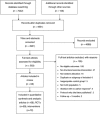The Contribution of Individual Exercise Training Components to Clinical Outcomes in Randomised Controlled Trials of Cardiac Rehabilitation: A Systematic Review and Meta-regression
- PMID: 28477308
- PMCID: PMC5419959
- DOI: 10.1186/s40798-017-0086-z
The Contribution of Individual Exercise Training Components to Clinical Outcomes in Randomised Controlled Trials of Cardiac Rehabilitation: A Systematic Review and Meta-regression
Abstract
Background: While the clinical benefits of exercise-based cardiac rehabilitation are well established, there is extensive variation in the interventions used within these trials. It is unknown whether variations in individual components of these exercise interventions provide different relative contributions to overall clinical outcomes. This study aims to systematically examine the relationship between individual components of the exercise intervention in cardiac rehabilitation (such as intensity and frequency) and clinical outcomes for people with coronary heart disease.
Methods: In this systematic review, eligible trials were identified via searches of databases (PubMed, Allied and Complementary Medicine, EMBASE, PEDro, Science Citation Index Expanded, CINAHL, The Cochrane Library, SPORTDiscus) from citation tracking and hand-searching. Studies were included if they were randomised trials of a structured exercise intervention (versus usual care) for participants with coronary heart disease and reported at least one of cardiovascular mortality, total mortality, myocardial infarction or revascularisation outcomes. Each included trial was assessed using the Cochrane Risk of Bias Tool. Authors were also contacted for missing intervention details or data. Random effects meta-analysis was performed to calculate a summary risk ratio (RR) with 95% confidence interval (CI) for the effect of exercise on outcomes. Random effects meta-regression and subgroup analyses were conducted to examine the association between pre-specified co-variates (exercise components or trial characteristics) and each clinical outcome.
Results: Sixty-nine trials were included, evaluating 72 interventions which differed markedly in terms of exercise components. Exercise-based cardiac rehabilitation was effective in reducing cardiovascular mortality (RR 0.74, 95% CI 0.65 to 0.86), total mortality (RR 0.90, 95% CI 0.83 to 0.99) and myocardial infarction (RR 0.80, 95% CI 0.70 to 0.92). This effect generally demonstrated no significant differences across subgroups of patients who received various types of usual care, more or less than 150 min of exercise per week and of differing cardiac aetiologies. There was however some heterogeneity observed in the efficacy of cardiac rehabilitation in reducing total mortality based on the presence of lipid lowering therapy (I 2 = 48%, p = 0.15 for subgroup treatment interaction effect). No single exercise component was identified through meta-regression as a significant predictor of mortality outcomes, although reductions in both total (RR 0.81, p = 0.042) and cardiovascular mortality (RR 0.72, p = 0.045) were observed in trials which reported high levels of participant exercise adherence, versus those which reported lower levels. A dose-response relationship was found between an increasing exercise session time and increasing risk of myocardial infarction (RR 1.01, p = 0.011) and the highest intensity of exercise prescribed and an increasing risk of percutaneous coronary intervention (RR 1.05, p = 0.047).
Conclusions: Exercise-based cardiac rehabilitation is effective at reducing important clinical outcomes in patients with coronary heart disease. While our analysis was constrained by the quality of included trials and missing information about intervention components, there appears to be little differential effect of variations in exercise intervention, particularly on mortality outcomes. Given the observed effect between higher adherence and improved outcomes, it may be more important to provide exercise-based cardiac rehabilitation programs which focus on achieving increased adherence to the exercise intervention.
Figures






References
-
- Australian Institute of Health and Welfare . Australia’s health 2014. Australia’s health series no. 14. Cat. no. AUS 178. Canberra: AIHW; 2014.
Publication types
LinkOut - more resources
Full Text Sources
Other Literature Sources

